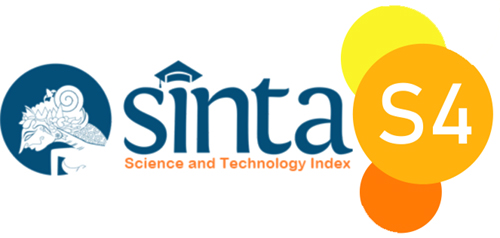Telegram Chatbot Implementation Using Rasa Framework to Recommend Tourism in Semarang City
 :
:
https://doi.org/10.32409/jikstik.23.1.3569
Keywords:
Rasa, Chatbot, Telegram, Natural Language Understanding, Natural Language ProcessingAbstract
In the context of the rapid development of tourism, especially in Semarang City which offers 1393 tourist attractions, the confusion of tourists in choosing a destination is a challenge. This research proposes the implementation of a chatbot on the Telegram platform as a solution to facilitate tourists in determining tourist destinations that match their preferences. The research method includes data collection, conversation model, system design and development, implementation, and testing. By involving representative respondents, the survey provides a holistic picture of their perceptions and assessments of various aspects, reflecting the level of satisfaction and providing valuable insights. The survey results provide the percentage of answers from the total respondents, strengthening the validity and reliability of the data. The implementation of the chatbot proved to significantly help travelers by cutting search time and providing a satisfying interactive experience. However, performance evaluation using the Classification Report showed results that require improvement. Therefore, the research emphasizes the need for improved Machine Learning and Deep Learning performance evaluation to ensure more optimal results on Classification Report in the future.Downloads
References
A. N. Cahaya, P. Ilmu, S. Pembangunan, and U. Diponegoro, “ANALISIS PERANAN SEKTOR PARIWISATA DI JAWA TENGAH ( PENDEKATAN INPUT-OUTPUT ) destinasi wisata , kemudahan mendapatkan tempat penginapan yang sesuai , tersedianya diserap oleh suatu unit tertentu yang membutuhkan tenaga kerja . Tenaga kerja yang kontribus,” vol. 11, no. September 2020, pp. 202–212, 2019.
A. T. Mumtaz and M. Karmilah, “Digitalisasi Wisata di Desa Wisata,” vol. 1, no. 1, pp. 1–15, 2021.
Cecep Abdul Cholik, “PERKEMBANGAN TEKNOLOGI INFORMASI KOMUNIKASI / ICT DALAM BERBAGAI BIDANG,” vol. 2, no. 2, pp. 39–46, 2021.
F. A. Astuti, “Pemanfaatan Teknologi Artificial Intelligence untuk Penguatan Kesehatan dan Pemulihan Ekonomi Nasional,” vol. 04, no. 01, pp. 25–34, 2021.
M. T. Zemčík, “A Brief History of Chatbots,” Int. Conf. Artif. Intell. Control Autom. Eng. (AICAE 2019), no. Aicae, pp. 14–18, 2019.
E. A. B, An Overview of Chatbot Technology. Springer International Publishing, 2020. doi: 10.1007/978-3-030-49186-4.
R. Ren, M. Zapata, J. W. Castro, O. Dieste, and S. T. Acuna, “Experimentation for Chatbot Usability Evaluation: A Secondary Study,” IEEE Access, vol. 10, pp. 12430–12464, 2022, doi: 10.1109/ACCESS.2022.3145323.
S. dan P. K. S. Dinas Komunikasi, Informatika, “SEMARANG SATU DATA.” Accessed: Dec. 20, 2023. [Online]. Available: https://semarsatata.semarangkota.go.id/data/list/4
A. Rogers and I. Augenstein, “What can we do to improve peer review in NLP?,” Find. Assoc. Comput. Linguist. Find. ACL EMNLP 2020, pp. 1256–1262, 2020, doi: 10.18653/v1/2020.findings-emnlp.112.
D. Schlangen, “Targeting the Benchmark: On Methodology in Current Natural Language Processing Research,” ACL-IJCNLP 2021 - 59th Annu. Meet. Assoc. Comput. Linguist. 11th Int. Jt. Conf. Nat. Lang. Process. Proc. Conf., vol. 2, pp. 670–674, 2021, doi: 10.18653/v1/2021.acl-short.85.
E. Chen and Y. H. Tseng, “A Decision Model for Designing NLP Applications,” WWW 2022 - Companion Proc. Web Conf. 2022, no. Figure 3, pp. 1206–1210, 2022, doi: 10.1145/3487553.3524921.
E. M. Bender and A. Koller, “Climbing towards NLU: On meaning, form, and understanding in the age of data,” Proc. Annu. Meet. Assoc. Comput. Linguist., no. 2, pp. 5185–5198, 2020, doi: 10.18653/v1/2020.acl-main.463.
A. S. Gillis, “natural language understanding (NLU),” Tech Target. Accessed: Dec. 22, 2023. [Online]. Available: https://www-techtarget-com.translate.goog/searchenterpriseai/definition/natural-language-understanding-NLU?_x_tr_sl=en&_x_tr_tl=id&_x_tr_hl=id&_x_tr_pto=tc
A. Jiao, “An Intelligent Chatbot System Based on Entity Extraction Using RASA NLU and Neural Network,” J. Phys. Conf. Ser., vol. 1487, no. 1, 2020, doi: 10.1088/1742-6596/1487/1/012014.
A. Lubis and I. Sumartono, “Implementasi Layanan Akademik Berbasis Chatbot untuk Meningkatkan Interaksi Mahasiswa,” Media Online, vol. 3, no. 5, pp. 397–403, 2023, [Online]. Available: https://djournals.com/resolusi
FAQ, “What is Telegram?,” Telegram. Accessed: Dec. 22, 2023. [Online]. Available: https://telegram.org/faq#q-what-is-telegram-what-do-i-do-here
M. Muchlisin, “The power of Telegram as a digital English learning media,” Retco 9 Natl. Semin. Unirow Tuban, no. 2016, pp. 12–19, 2019, [Online]. Available: https://t.me/ximmaaye.
A. Turner, “How Many Users Does Telegram Have (Dec 2023),” BankMyCell. Accessed: Dec. 22, 2023. [Online]. Available: https://worldpopulationreview.com/country-rankings/telegram-users-by-country
D. Wulandari and J. Sasongko Wibowo, “Implementasi Chatbot Menggunakan Framework Rasa Untuk Layanan Informasi Wisata Di Kota Pati,” J. Inf. Technol. Comput. Sci., vol. 6, no. 2, 2023.
R. Rismanto, Y. Yunhasnawa, and R. A. Bhakti, “Penerapan Metode Cosine Similarity Dalam Aplikasi Chatbot Layanan Wisata Di Wilayah Malang,” Semin. Inform. Apl. Polinema, pp. 1–8, 2019, [Online]. Available: http://jurnalti.polinema.ac.id/index.php/SIAP/article/view/683
V. No, O. Hal, A. Dwi, and S. Naja, “Pengembangan Chatbot untuk Informasi Wisata Interaktif di Tangerang Selatan menggunakan Framework Rasa,” vol. 5, no. 4, pp. 476–483, 2023.
ngrok, “What is ngrok?,” 21 February. Accessed: Dec. 26, 2023. [Online]. Available: https://ngrok.com/docs/what-is-ngrok/
V. Vijayaraghavan, J. B. Cooper, and R. L. Rian Leevinson, “Algorithm Inspection for Chatbot Performance Evaluation,” Procedia Comput. Sci., vol. 171, no. 2019, pp. 2267–2274, 2020, doi: 10.1016/j.procs.2020.04.245.
R. Bierig, S. Brown, E. Galván, and J. Timoney, “Black-Box and White-Box Testing,” in Essentials of Software Testing, Cambridge: Cambridge University Press, 2021, pp. 141–164.
P. Pandit and S. Tahiliani, “AgileUAT: A Framework for User Acceptance Testing based on User Stories and Acceptance Criteria,” Int. J. Comput. Appl., vol. 120, no. 10, pp. 16–21, 2015, doi: 10.5120/21262-3533.
A. Kharwal, “Classification Report in Machine Learning,” Thecleverprogrammer.com. Accessed: Jan. 06, 2024. [Online]. Available: https://thecleverprogrammer.com/2021/07/07/classification-report-in-machine-learning/
Downloads
Published
How to Cite
Issue
Section
Categories
 Abstract View: 0 times
Abstract View: 0 times








